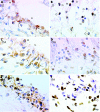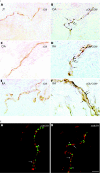Beta-endorphin, Met-enkephalin and corresponding opioid receptors within synovium of patients with joint trauma, osteoarthritis and rheumatoid arthritis
- PMID: 17324971
- PMCID: PMC1955126
- DOI: 10.1136/ard.2006.067066
Beta-endorphin, Met-enkephalin and corresponding opioid receptors within synovium of patients with joint trauma, osteoarthritis and rheumatoid arthritis
Abstract
Objective: Intra-articularly applied opioid agonists or antagonists modulate pain after knee surgery and in chronic arthritis. Therefore, the expression of beta-endorphin (END), Met-enkephalin (ENK), and mu and delta opioid receptors (ORs) within synovium of patients with joint trauma (JT), osteoarthritis (OA) and rheumatoid arthritis (RA) were examined.
Methods: Synovial samples were subjected to double immunohistochemical analysis of opioid peptides with immune cell markers, and of ORs with the neuronal markers calcitonin gene-related peptide (CGRP) and tyrosine hydroxylase (TH).
Results: END and ENK were expressed by macrophage-like (CD68(+)) and fibroblast-like (CD68(-)) cells within synovial lining layers of all disorders. In the sublining layers, END and ENK were mostly expressed by granulocytes in patients with JT, and by macrophages/monocytes, lymphocytes and plasma cells in those with OA and RA. Overall, END- and ENK-immunoreactive (IR) cells were more abundant in patients with RA than in those with OA and JT. ORs were found on nerve fibres and immune cells in all patients. OR-IR nerve fibres were significantly more abundant in patients with RA than in those with OA and JT. muORs and deltaORs were coexpressed with CGRP but not with TH.
Conclusions: Parallel to the severity of inflammation, END and ENK in immune cells and their receptors on sensory nerve terminals are more abundant in patients with RA than in those with JT and OA. These findings are consistent with the notion that, with prolonged and enhanced inflammation, the immune and peripheral nervous systems upregulate sensory nerves expressing ORs and their ligands to counterbalance pain and inflammation.
Conflict of interest statement
Competing interests: None declared.
Similar articles
-
Endorphin and enkephalin ameliorate excessive synovial cell functions in patients with rheumatoid arthritis.J Rheumatol. 2001 Oct;28(10):2176-83. J Rheumatol. 2001. PMID: 11669152
-
Comparative Expression Analyses of Pro- versus Anti-Inflammatory Mediators within Synovium of Patients with Joint Trauma, Osteoarthritis, and Rheumatoid Arthritis.Mediators Inflamm. 2017;2017:9243736. doi: 10.1155/2017/9243736. Epub 2017 Feb 20. Mediators Inflamm. 2017. PMID: 28316377 Free PMC article.
-
[A study of opioid peptides in synovial fluid and synovial tissue in patients with rheumatoid arthritis].Arerugi. 1992 May;41(5):615-20. Arerugi. 1992. PMID: 1520070 Japanese.
-
Opioid receptors and their ligands in the musculoskeletal system and relevance for pain control.Curr Pharm Des. 2013;19(42):7382-90. doi: 10.2174/13816128113199990363. Curr Pharm Des. 2013. PMID: 23448480 Review.
-
Leukocyte trafficking between stromal compartments: lessons from rheumatoid arthritis.Nat Rev Rheumatol. 2018 Aug;14(8):476-487. doi: 10.1038/s41584-018-0042-4. Nat Rev Rheumatol. 2018. PMID: 30002464 Review.
Cited by
-
L-364,718 potentiates electroacupuncture analgesia through cck-a receptor of pain-related neurons in the nucleus parafascicularis.Neurochem Res. 2011 Jan;36(1):129-38. doi: 10.1007/s11064-010-0281-5. Epub 2010 Oct 16. Neurochem Res. 2011. PMID: 20953702
-
A Closer Look at Opioid-Induced Adrenal Insufficiency: A Narrative Review.Int J Mol Sci. 2023 Feb 26;24(5):4575. doi: 10.3390/ijms24054575. Int J Mol Sci. 2023. PMID: 36902007 Free PMC article. Review.
-
Opioid Receptors in Immune and Glial Cells-Implications for Pain Control.Front Immunol. 2020 Mar 4;11:300. doi: 10.3389/fimmu.2020.00300. eCollection 2020. Front Immunol. 2020. PMID: 32194554 Free PMC article. Review.
-
Comparison of efficacy of intra-articular morphine and steroid in patients with knee osteoarthritis.J Anaesthesiol Clin Pharmacol. 2012 Oct;28(4):496-500. doi: 10.4103/0970-9185.101940. J Anaesthesiol Clin Pharmacol. 2012. PMID: 23225932 Free PMC article.
-
Pathway Phenotypes Underpinning Depression, Anxiety, and Chronic Fatigue Symptoms Due to Acute Rheumatoid Arthritis: A Precision Nomothetic Psychiatry Analysis.J Pers Med. 2022 Mar 16;12(3):476. doi: 10.3390/jpm12030476. J Pers Med. 2022. PMID: 35330475 Free PMC article.
References
-
- Stein C, Schäfer M, Machelska H. Attacking pain at its source: new perspectives on opioids [review]. Nat Med 200391003–1008. - PubMed
-
- Oeltjenbruns J, Schäfer M. Peripheral opioid analgesia: clinical applications [review]. Curr Pain Headache Rep 2005936–44. - PubMed
-
- Coggeshall R E, Zhou S, Carlton S M. Opioid receptors on peripheral sensory axons. Brain Res 1997764126–132. - PubMed
-
- Barber A, Gottschlich R. Opioid agonists and antagonists: an evaluation of their peripheral actions in inflammation. Med Res Rev 199212525–562. - PubMed
Publication types
MeSH terms
Substances
LinkOut - more resources
Full Text Sources
Medical
Research Materials
Miscellaneous





